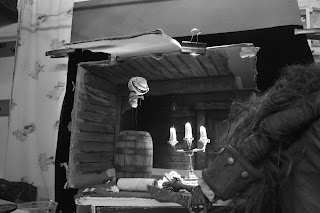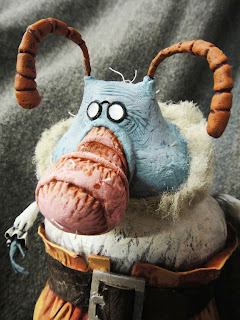Finally, about midway through 2015, with all the characters and main props finished, it was time to start photography. I bought myself a Nikon 3200 camera, set up the first scene (Smeck on his island), and began experimenting with lighting, at the same time teaching myself how to use the camera manually. It took me precisely 223 shots before I got a result I was happy with (I took well over 2,000 photos overall — Thank god for digital cameras!)
I didn’t have any special lighting at my disposal, just three desk lamps, an animation light-box and miscellaneous lights. I lighted the scenes with a fill light, which was essentially just a pedestal light behind a sheet. I had a metre long LED light to highlight the painted sky. And I used a key light, usually representing sunlight, which created nice highlights and shadows. White reflective cardboard was usually out of shot to take away some of the harshness of the shadows created by the key-light. To add a bit of warmth or coolness to a scene I used coloured cellophane over the lights (very sophisticated). I sometimes used multiple layers and colour combinations until I got the colour just right. It was an extremely finicky process.
When I started photography, I wanted to do as much work ‘in-camera’ as I possibly could. I new there would be extensive work to do in photoshop later on anyway, and as I don’t particularly enjoy working in photoshop I wanted to minimise that workload down the track. This thinking applied to the coloration of the scene, but also with the effects. Some would argue it would be easier to just do it all in photoshop, but I enjoy problem-solving and coming up with imaginative solutions using more primitive methods.
There are many instances where I used optical illusion to bring characters together. As I mentioned, the Sea Thingy was not to scale with Minnie or Smeck, so where possible, when they appear in the same shot together I would place the Sea Thingy in the foreground, and the characters in the extreme background. Looking at a Television screen which I had linked up to the camera, I would carefully line up the characters, often using a whiteboard marker to make reference lines. To keep everything in focus I set the aperture to f/32 and the exposure to 30 seconds. This made the depth of field very shallow so Minnie appears to be sitting on the Sea Thingy’s shell.
To create fog in this same scene I made what I called my “fog stick”, which was a small length of dowling with hobby fill wrapped roughly around it. Taking advantage of the 30 second exposure I would poke the fog stick in and out of the shot in the background. It helped create convincing fog. I did the same trick with this night time scene...
To create fog in this same scene I made what I called my “fog stick”, which was a small length of dowling with hobby fill wrapped roughly around it. Taking advantage of the 30 second exposure I would poke the fog stick in and out of the shot in the background. It helped create convincing fog. I did the same trick with this night time scene...
There are many other pages where I used these same cheap tricks. To create an aurora borealis effect I used just a green-tinted light, and my arms, moving in such a way that it looked like I was doing a 30 second piece of performance art.
The most effective example of forced perspective, and the one I am happiest with, was the scene with the Sea Thingy having an encounter with another Deep-Sea Thingy. These two creatures were nowhere near to scale with each other, the latter being far smaller. It was constructed using wire armature, aluminium foil, and Sculpey. I paid particular attention to fine details so that it would still look good blown up next to the Sea Thingy. Again, I carefully positioned it close to the camera, and the Sea Thingy at least a metre or so behind, with crumpled blue/green painted paper filling in the gaps and covering up flaws.
The aperture was set to f/36, with 30 second exposures. During the long exposure I used a moving torch to highlight the Sea Thingy’s face in the background, then the Deep-Sea Thingy’s face in the foreground — this represented light projected from the Deep-Sea Thingy’s bioluminescent light. An intense foggy glow was added later in photoshop, along with foreground fog. I was very pleased with how seamlessly it all came together. It’s a shame to not see this picture in all it’s glory in the finished book, so here is it —
The most effective example of forced perspective, and the one I am happiest with, was the scene with the Sea Thingy having an encounter with another Deep-Sea Thingy. These two creatures were nowhere near to scale with each other, the latter being far smaller. It was constructed using wire armature, aluminium foil, and Sculpey. I paid particular attention to fine details so that it would still look good blown up next to the Sea Thingy. Again, I carefully positioned it close to the camera, and the Sea Thingy at least a metre or so behind, with crumpled blue/green painted paper filling in the gaps and covering up flaws.
The aperture was set to f/36, with 30 second exposures. During the long exposure I used a moving torch to highlight the Sea Thingy’s face in the background, then the Deep-Sea Thingy’s face in the foreground — this represented light projected from the Deep-Sea Thingy’s bioluminescent light. An intense foggy glow was added later in photoshop, along with foreground fog. I was very pleased with how seamlessly it all came together. It’s a shame to not see this picture in all it’s glory in the finished book, so here is it —
Another scene which has a nice atmosphere is the one with Smeck meeting the pirates for the first time. I wanted a very visible shaft of light pouring down on Smeck. Instead of doing it the easy (and far healthier) way with Photoshop, again taking advantage of the long exposure, I puffed away on a cigar madly blowing smoke from off camera into the scene. This was a last resort after having experimented unsuccessfully with a homemade smoke machine (boiling water and glycerin), and burning mosquito coils. Having removed the batteries from the smoke alarm in my studio, I took a number of photos blowing smoke until I got the haze just right, but I felt dizzy for the rest of the day. It was just one of many “what the hell am I doing?” moments.
The photographs I left until last and were giving me headaches whenever I thought about them, were the sepia panels in the middle of the story. The one saving grace was not having to worry about colour. It was a joy working in black and white, where I could focus solely on light and shadow, and I could cheat endlessly with strategically placing random out-of-focus objects in the foreground and background.
But there was no escaping having to make a heap of props. Things like an axe-grinder, a cannon, cannon balls, a bucket, a barrel, a cauldron, stools, the captains table with maps, telescope, ink well, goblets, sword and candles (with photoshopped flames), a laundry bucket, underwear, and an assortment of fruits and vegetables...
In a few of the panels there are what appear to be suds. This was achieved using small pearl beads which were held together with hair styling clay (I read this is how Aardman animate suds in Wallace and Gromit and Shaun The Sheep).
Everything else was bric-a-brac lying about my studio.
But there was no escaping having to make a heap of props. Things like an axe-grinder, a cannon, cannon balls, a bucket, a barrel, a cauldron, stools, the captains table with maps, telescope, ink well, goblets, sword and candles (with photoshopped flames), a laundry bucket, underwear, and an assortment of fruits and vegetables...
In a few of the panels there are what appear to be suds. This was achieved using small pearl beads which were held together with hair styling clay (I read this is how Aardman animate suds in Wallace and Gromit and Shaun The Sheep).
Everything else was bric-a-brac lying about my studio.





































































